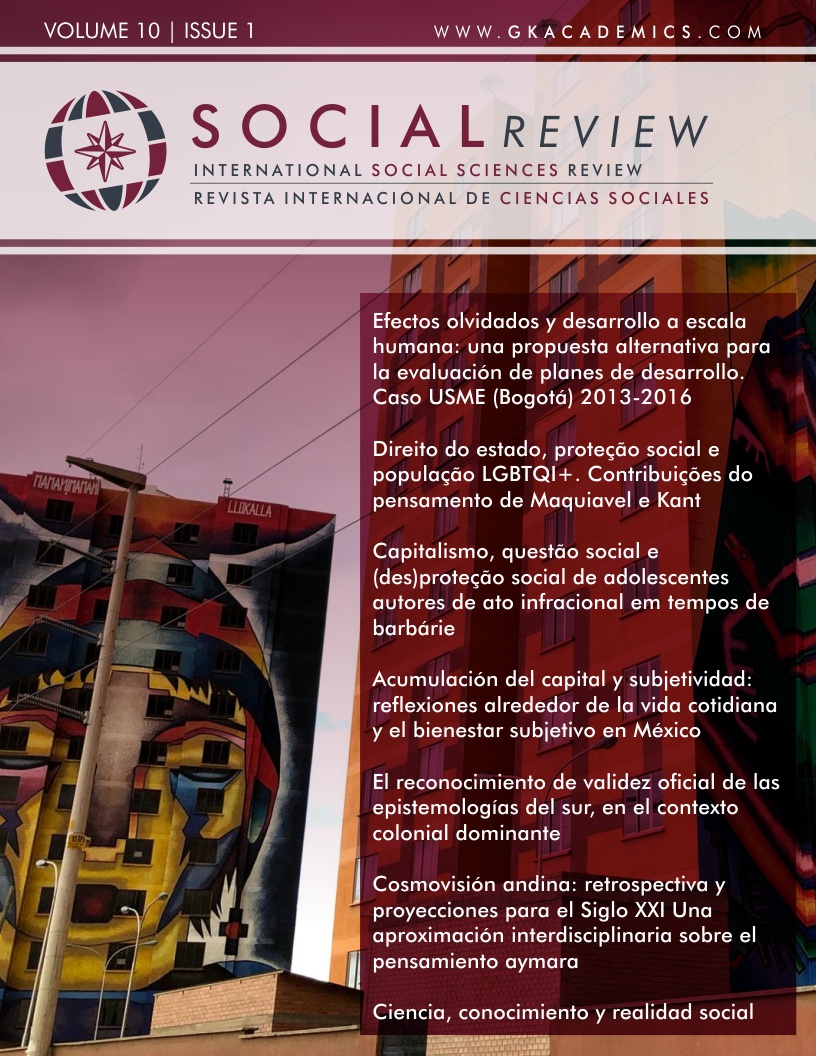Forgotten Effects and Development on a Human Scale, an Alternative Proposal for the Evaluation of Development Plans - Case: USME (Bogotá) 2013-2016
DOI:
https://doi.org/10.37467/gka-revsocial.v10.2441Keywords:
Development Plan, Human Scale, Forgotten Effects, Satisfactory, Complexity, Incentive, Behavior, Public PolicyAbstract
Between 2012 and 2016, the Mayor's Office of Bogotá, Colombia, executed a Development Plan (PD) called “Bogotá Humana”. In order to alternatively evaluate the incidences of this PD and that local phenomena with high degrees of complexity were not deformed, simplified or separated from reality, the proposal of Development on a Human Scale, was used together with the alternative of identification of Forgotten Effects. Obtaining in this evaluation, routes with probabilities of occurrence of forgotten effects on fundamental basic human needs greater than 8%. The existence of synergy was demonstrated, by presenting characteristics of multiple incidence.
Downloads
Global Statistics ℹ️
|
569
Views
|
192
Downloads
|
|
761
Total
|
|
References
Abarca, A. (2002). Las políticas públicas como perspectiva de análisis. Ciencias Sociales, 97(III),95-103.
Alcaldía Mayor. (2011). Exposición de motivos. Disponible en: http://www.sdp.gov.co/portal/page/portal/PortalSDP/Home/Noticias/OtrosDocumentosArchivados/PlandeDesarrollo/Exposicion_Motivos_Plan_Bogota_Humana_20120430.pdf . Acceso en 21 de enero. 2018.
Concejo de Bogotá. (2012). Plan de desarrollo 2012-2016. Disponible en: http://www.sdp.gov.co/portal/page/portal/PortalSDP/Home/Noticias/OtrosDocumentosArchiv ados/PlandeDesarrollo/Acuerdo_489_2012_PDD.pdf.
Cruz, I., Atahel, A., y Max-Neef, M. (2009). Towards a Systematic Development Approach: Building on the Human-Scale Development Paradigm. Ecological Economics, 68(7), 2021-2030. DOI: https://doi.org/10.1016/j.ecolecon.2009.02.004
Cunningham, W. P. y Saigo, B. W. (2001). Environmental Science: A global concern. Boston: McGraw-Hill.
Ducey, M. y Larson, B. (1999). A fuzzy set approach to the problem of sustainability. Forest Ecology and Management, 115(1), pp. 29-40. DOI: https://doi.org/10.1016/S0378-1127(98)00433-2
Flores, R. (2009). La entrevista como técnica de investigación social. En R. Flores, Observando observadores: Una Introducción a las técnicas cualitativas. Santiago: Universidad Católica de Chile.
Gil-Lafuente, A. y Kyun, Y. (2012). Incidencia de las inversiones de la administración pública sobre el desarrollo turístico de una ciudad. Revista Venezolana de Gestión Pública, 3(3), pp. 81-109.
Guba, E., y Lincoln, Y. (2002). Paradigmas en competencia en investigación cualitativa. En C. Denham, y J. Haro, Por los rincones. Antología de métodos cualitativos en la investigación social. Región y sociedad, 14(23), 364.
Jiménez, J. & Podestá, A. (2009). Inversión, incentivos fiscales y gastos tributarios en América Latina. Publicación de las naciones Unidas. Santiago de Chile.
Junta Administradora local de Usme. Acuerdo Local 002 de 2012. Disponible en: http://www.alcaldiabogota.gov.co/sisjur/normas/Norma1.jsp?i=50127 Acceso en 21 de enero. 2018.
Kaufmann, A. y Gil-Aluja, J. (1986). Introducción de la teoría de los subconjuntos borrosos a la gestión de las empresas. Santiago de Compostela: Milladoiro.
Kaufmann, A. y Gil-Aluja, J. (1988). Técnicas operativas de gestión para el tratamiento de la incertidumbre. Santiago de Compostela: Hispano Europea.
Manna, E. M., Rojas, J., y Mondaca C. (2018). Application of the Forgotten Effects Theory for Assessing the Public Policy on Air Pollution of the Commune of Valdivia, Chile, Springer, 61-72. DOI: https://doi.org/10.1007/978-3-319-65687-8_6
Max-Neef, M., Elizalde, A. y Hopenhayn, M. (1986). Desarrollo a escala humana Opciones para el futuro. Santiago, Chile: CEPAUR.
Muñoz, M. J., Rivera, J. M. y Moneva, J. M. (2008). Evaluating sustainability in organisations with a fuzzy logic approach. Industrial Management & Data Systems, 108(6), pp. 829-841. DOI: https://doi.org/10.1108/02635570810884030
Phillis, Y. y Andriantiatsaholiaina, L. (2001). Sustainability: an ill-defined concept and its assessment using fuzzy logic. Ecological Economics, 37(3), pp. 435-56. DOI: https://doi.org/10.1016/S0921-8009(00)00290-1
Pinzon, F. (2015). Escapadas por Colombia. Bogotá: El Tiempo.
Rittel, H. y Webber, M. (1973). Dilemmas in a general theory of planning. Policy Sciences, 4(2), pp. 155-169. DOI: https://doi.org/10.1007/BF01405730
Sánchez, L. y Ramírez, J. (2010). Propuesta de un modelo para la evaluación de impactos de programas sociales desde las teorías de desarrollo a escala humana y las dimensiones de la sostenibilidad. Foro virtual de contabilidad ambiental y social.
Secretaría Distrital de Planeación. (2011). Guía para la formulación ejecución y evaluación de los planes de desarrollo distrital y local. Disponible en: http://www.sdp.gov.co/portal/page/portal/PortalSDP/Home/Noticias/OtrosDocumentosArchiv ados/GuiaPlanesDesarrollo/Guia_formulacion_PDD_PDL.pdf.
Downloads
Published
How to Cite
Issue
Section
License
Those authors who publish in this journal accept the following terms:
-
Authors retain copyright.
-
Authors transfer to the journal the right of first publication. The journal also owns the publishing rights.
-
All published contents are governed by an Attribution-NoDerivatives 4.0 International License.
Access the informative version and legal text of the license. By virtue of this, third parties are allowed to use what is published as long as they mention the authorship of the work and the first publication in this journal. If you transform the material, you may not distribute the modified work. -
Authors may make other independent and additional contractual arrangements for non-exclusive distribution of the version of the article published in this journal (e.g., inclusion in an institutional repository or publication in a book) as long as they clearly indicate that the work was first published in this journal.
- Authors are allowed and recommended to publish their work on the Internet (for example on institutional and personal websites), following the publication of, and referencing the journal, as this could lead to constructive exchanges and a more extensive and quick circulation of published works (see The Effect of Open Access).













